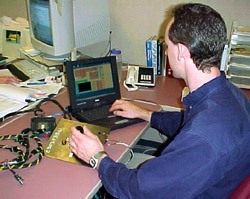
Winch engineer Eric Bracht uses a laptop computer to
verify the program performance. Installation is a simple matter of just
plugging the control wire to the winch.
|
|
Who says you can't teach an old dog new tricks? Certainly not the talented engineers at Allied Systems Company. They've got that rock-solid Allied winch dancing to the digital beat.
Up until now, the Allied winch has been operated with a manual push-pull cable. The cable connects to the hydraulic valve inside the winch to direct the winch functions. To stay current with the latest trends in the industry, Allied now offers eControls, the electronic control option, starting with its W12E towing winch. Other models will follow.
With electronic control, the standard hydraulic valve is replaced with a set of individual hydraulic valves, each operated by a solenoid. A microprocessor sits between the joystick handlever and the solenoids, to convert handle position information into the appropriate valve position.
A major design goal of the electronic control system was to provide the operator with greatly improved inching capability, the ability to control line position to within a fraction of an inch. A related secondary goal was to reduce roll-back to zero. Roll-back is the tendency of the cable under load to play out a small bit before it starts to reel in when operating in line-in position. Winch Engineer Eric Bracht explored many settings to finally arrive at the one that delivers on both these goals.
|
|
Electronic winch control offers several advantages to your winch customers. Electronic control is easy to install, because the compact control handle can be mounted almost anywhere. In cold weather conditions, electronic control is not susceptible to freezing, which can block a manual cable. Electronic control is a fingertip control, so operator fatigue is reduced.
The biggest advantage to electronic control is the ability to control the position of the load. The Allied winch with manual control has inching capability, but controlling line position accurately requires a precise touch on the manual control lever. With electronic control, inching has become much easier, allowing even an inexperienced operator to position the load right where it's needed.
The first real-world test of the new eControls was on the 120,000-lb. line pull W12E winch in a phosphate mine in south Florida. Allied Engineer Eric Bracht traveled with Scott Bassett of Ringhaver Equipment in Mulberry, Florida to the job site in Ft. Meade, Florida to observe the W12E mounted on a Cat D9R. The D9R is fitted with a boom, so that the operator can lift lengths of slurry pipe and position them to connect with the next length of pipe. Line position is critical, because the pipe sections are bolted together. To get the bolts started, the two sections need to be closely aligned.
From the first day, the electronic control has been a success. Productivity is enhanced because the operator can get the pipe section in position so much faster.
The winch has been operating now for three months. The design and implementation are well done, and the customer is very satisfied.
The electronic control option for W12E is available today. It will appear as an option on the new price sheet to be issued in 2002.
We're not stopping here. Be looking for electronic controls to appear on other Allied winches in the future.
|
|